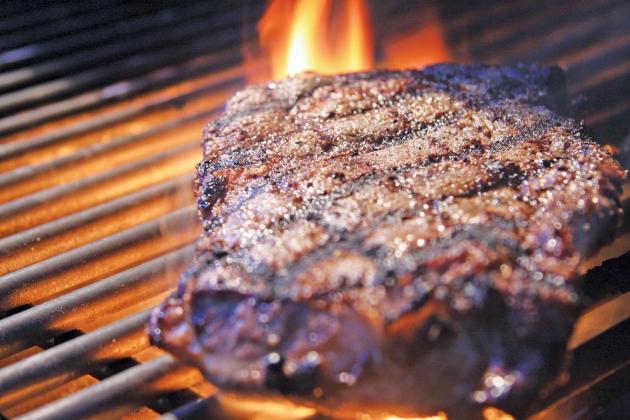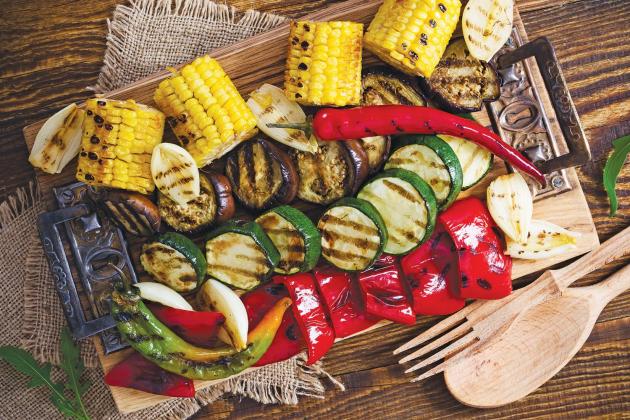GET GRILLING!
5 BASIC STEPS FOR SIZZLING STEAK
A sizzling steak is a surefire sound of summer, and the flavors achieved from one that’s perfectly grilled are hard to match. Before you fire up your grill, consider these five basics for cooking a chef-worthy steak:
1. PREPARE YOUR CUT – Taste preferences (and prices) may differ among sirloins, ribeyes, T-bones and more, but the way you prepare steaks likely won’t change much from cut to cut. You’ll want to trim the thickness down to 1/2-1 inch for proper cooking, and setting the meat out ahead of time allows it to warm to room temperature before hitting the grill. Placing a refrigerator-cool slab on hot grates works against you in two ways: first, the cold meat instantly chills your previously warm grill, and second, the inner portion of the steak will take longer to grill.
2. ADD SOME SALT – Feel free to add any spices that you prefer, but remember a good steak typically doesn’t require fancy seasoning – a pinch of salt works just fine. Add your salt anywhere between 30 minutes to a few hours before grilling time to help retain moisture and improve flavor.
3. AIM FOR HIGH HEAT – Grilling a steak correctly actually isn’t just about maintaining a sweltering flame. A two-zone fire is usually the way to go – one side of the grill should be hot (using direct heat) with the other side not quite as warm (indirect heat). This allows you to create a sear over direct heat before finishing cooking through – without burning – over indirect heat.
4. SEAR AND SLIDE – Speaking of searing: Cooking your steak over direct heat 1-2 minutes on each side is normally about right for creating a proper sear. At this point, depending on the thickness of your steak, you’ll want to check for doneness. If it’s not quite to the temperature you’re looking to achieve, simply slide it over to the indirect heat for a finishing touch.
Keep in mind these general guidelines for doneness: 120-125 F is rare, 130-135 F is medium-rare, 140-145 F is medium, 150-155 F is medium-well and 160-175 F is well done.
5. LET REST – Finally, as hungry as you may be at this point, resting steaks is an important last step before diving in. Giving your steaks 5-10 minutes (foil or no foil) allows flavors to redistribute and moisture to be retained in the meat.
5 BASIC STEPS TO GRILL VEGETABLES
Burgers, brats, steak, chicken, pork chops and all the flavors of fresh meat get all the love on the grill, but a well-rounded meal calls for sides and veggies. Before you plan your next backyard barbecue, incorporate tasty vegetables – peppers, asparagus, onions, tomatoes, zucchini and more – for an all-out blitz of fresh-grilled flavor. Consider these 5 steps to properly grill your veggies:
1. LIGHT THE GRILL – Step one, of course, is to prep a hot grill. For the best cooking experience, you’ll want medium-high heat or even high heat for quick, direct grilling. By lighting the grill ahead of prep, you’ll allow plenty of heating time to complete your other tasks.
2. PREPARE VEGETABLES – There’ll likely be some preparation to undertake, such as cutting off stems and blemishes or removing pits and seeds. In addition to cleaning up your ingredients, you may want to chop, dice or slice based on the recipe.
3. COAT VEGETABLES WITH OLIVE OIL – Drizzling just a small amount of olive oil over your vegetables and tossing to coat adds a couple benefits. First, it helps the outer layer crisp rather than dry out, plus it aids in seasonings – like salt and pepper – sticking to the vegetable instead of falling off while on the grill or in a pan.
4. CONSIDER USING FOIL PACKETS OR SKEWERS – If char marks aren’t your thing, tossing chopped or diced veggies into a foil packet before hitting the grill steams them for a bit of a softer texture. Alternately, wooden skewers soaked in water (to prevent burning) can help keep smaller chunks of veggies from slipping through the grill grates while still achieving a crispy exterior.
5. PAY ATTENTION TO GRILL TIMES – Different types of vegetables and preparation methods call for different cook times, but 5-10 minutes over direct heat generally gets the job done. The smaller you chunk, chop, slice or dice, the less time it’ll take.
Find more cooking tips and recipes at Culinary.net . Photos courtesy of Getty Images.


